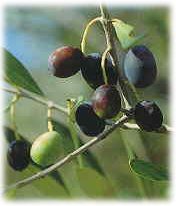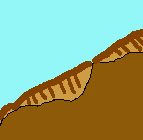taggiasca.com
Agronomic situation
of the olive groves
in Province of Imperia


Speaking about the Liguria olivicolture it's important
to cosiderate the aspects connected to the cultivation that allow to
evidence the peculiar characteristics that clearly differentiate it
from that one of the other Italian regions where olives are grown.
As described in the pages about the territory, the
cultivation is developed without solution of continuity until an elevation of approximately 600 meters.
The olivicolture of the province is characterized for
climatic, orographic, structural and social aspects very particular.
From theclimatic point of view, in wide
part, the area re-enters in the warm and medium subzone of the olive tree;
from this point of view the territory of the province is particularly
favorite, although the zones of the inner valleys are not free from cold damages.
From the orographic point of view the
greater part of the olive groves, not to say nearly the
totality, is placed in hilly zone, considering that the coastal
zone, once the richest of olive trees, now is widely antropized, and in the zone of Sanremo, used as flower cultivation.
 The hilly zone is largely characterized by slopes so emphasized that they have rendered necessary, for the takeover of the cultivation happened in the course of the centuries, the sistemation of the slopes with terraces and steps.
The hilly zone is largely characterized by slopes so emphasized that they have rendered necessary, for the takeover of the cultivation happened in the course of the centuries, the sistemation of the slopes with terraces and steps.
Often it has been provided to construction of the agrarian substrate, after the realization of stonewalls to contain a
reduced layer of ground taken at mount and transported on the place.
It's esteemed that beyond 90% of the olive groves surface is terraced,
taking place into a difficult and impervious environment that characterizes the agrarian landscape of the entire province.
Perhaps a landscape constructed from the hard work of
the peasant man, than has demanded many generazioi for stabilizzarsi.
Giovanni Boine in 1911 describes in detail the situation of crisis and poverty in which our grandfathers live, in contrast to the wealth of the traders of the coastal areas.
Ligurian peasants, capable and noble, said Boine, worked tenaciously in the centuries and, instead to build temples and palaces, have constructed the stonewalls as they were ciclopean temples.
Difficult ground is ours, rendered not miser just thanks to the presence of the olive tree that, in spite of the impervious ground, can express a good vegetative activity in virtue of the favorable climate.
From the structural point of view the groves are characterized by an elevated plantation density that, in some cases, exceed abundantly the 500 trees/hectare (200 trees/acre).
The excessive density is the main cause of the exceptional vertical development of the plants that come to assume the character of forest plants.
What said can be still noticed in the plantations not very cultivated or conducted by old peasants, still linked to the mentality that a tree the double large produces a double quantity of olives: condition discredited by a study of G. Fontanazza in 1989.
Must be said, however, that who need to restructure the olive grove by now has made it, also thanks to the regional contributions.
Speaking about social aspects of the cultivation of the olive
tree, we cannot speak of the peasant misery and poverty as Boine emphasized at the beginning of the century, as for that, in fact, it's changed the figure of the cultivator.
The young who takes care himself of olivicolture, is not nearly never an agriculturist to full time, but a laborer, an employee, a craftsman who handed on the passion for the ground from the own parents, cultivating part-time its small olive grove, often received in inheritance.
However,independently from the will of the olivicultor, an orographic conditioning exists that does not concur the use of machines not even for the execution of the ordinary coltural practices, which remains tied to the manual activity of the man who is forced to use simple tools.
The only exception is given from some particular small motorploughs, for the working of the terraces and requirements of transport, brushcutters for the mowing and small chainsaws to help in the pruning.
Even if in many Ligurian does not lack the will to
continue with tenacity to cultivate the olive trees, the insufficient
presence of workers and the requirement of a remarkable amount of
labor caused a sensitive restriction of the cultivated olive areas.
The first to be definitively abandoned are those placed in impervious environment and far from the inhabited centers, where the irreversible degradation of the enviroment is risked and, beyond affecting the landscaped order negatively, does not guarantee enough hydrogeological protection to the territory.
Thanks to the positive evolution of the world-wide market of
the olive oil, to several national and European laws tending to
advantage the typical and valuable oil production, we
nourish the hope that our product becomes remunerative so as to
attract other olivicultors to resume the activity.
copyright © 1999 - 2000 by It-Web Information Technology - all rights reserved